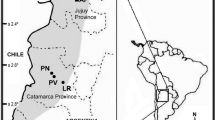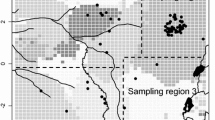Abstract
Since being declared extinct in the wild in 1972, the Arabian oryx has been the subject of intense and sustained effort to maintain a healthy captive population and to reintroduce the species to its ancestral range. Previous reintroductions and associated genetic assessments focused on the release of closely managed zoo animals into Oman and included observations of inbreeding and outbreeding depression. Here we describe the use of multiple unmanaged herds as source populations for a new reintroduction project in the United Arab Emirates, allowing a comparison between studbook management and uncontrolled semi-captive breeding approaches to the conservation of genetic diversity. Results of mitochondrial control region sequencing and 13-locus microsatellite profiling highlight a severe lack of diversity within individual source populations, but a level of differentiation among populations that supports the formation of a mixed founder herd. The combined release group contained a similar level of diversity to each of the intensively managed captive populations. The research includes the first genetic data for animals held on Sir Bani Yas Island, a former private reserve which until recently held over 50% of the world’s Arabian and scimitar-horned oryx and is recognized as having huge potential for re-establishing endangered antelope species in the wild. The genetic assessment provides the first stage of an ongoing genetic monitoring programme to support future supplemental releases, translocations and genetic management of reintroduced populations.




Similar content being viewed by others
References
Al Quarqaz M and Kiwan K (2007) Arabian Oryx release program, Abu Dhabi Emirate, United Arab Emirates. In: Soorae PS (ed) Reintroduction News, Newsletter of the IUCN/SSC Re-Introduction Specialist Group, Abu Dhabi, UAE, No. 26, pp 49–51. ISSN: 1560–3709
Al Zaidaneen L, Al Hasaseen AA (2008) Global re-introduction perspectives: re-introduction case-studies from around the globe, IUCN/SSC Re-introduction Specialist Group, Abu Dhabi, pp 181–184
Allendorf FW, Luikart G (2007) Conservation and the genetics of populations. Blackwell, Oxford
Alpers DL, VuurenBJ Van, Arctander P, Robinson TJ (2004) Population genetics of the roan antelope (Hippotragus equinus) with suggestions for conservation. Mol Ecol 13(7):1771–1784
Bandelt HJ, Forster P, Rohl A (1999) Median-joining networks for inferring intraspecific phylogenies. Mol Biol Evol 16(1):37–48
Buchanan FC, Crawford AM (1993) Ovine microsatellites at the OarFCB11, OarFCB128, OarFCB193, OarFCB266 and OarFCB304 loci. Anim Genet 24:145
Buchanan FC, Galloway SM, Crawford AM (1994) Ovine microsatellites at the OarFCB5, OarFCB19, OarFCB20, OarFCB48, OarFCB129 and OarFCB226 loci. Anim Genet 25(1):60
Ciofi C, Caccone A, Beheregaray LB, Milinkovitch MC, Russello M, Powell JR (2009) Genetic and conservation on islands: the Galapagos giant tortoise as a case study. In: Bertorelle G, Bruford MW, Hauffe HC, Rizzoli A, Vernesi C (eds) Population genetics for animal conservation. Cambridge University Press, Cambridge, pp 269–293
Cornuet JM, Luikart G (1996) Description and power analysis of two tests for detecting recent population bottlenecks from allele frequency data. Genetics 144:2001–2014
Ede AJ, Pierson CA, Crawford AM (1995) Ovine microsatellites at the OarCP9, OarCP16, OarCP20, OarCP21, OarCP23 and OarCP26 loci. Anim Genet 26:129–130
Excoffier L, Laval G, Schneider S (2005) Arlequin ver. 3.0: an integrated software package for population genetics data analysis. Evol Bioinformatics Online 1:47–50
Frankham R, Balloux JD, Eldridge MDB, Lacy RC, Ralls K, Dudash MR, Fenster CB (2010) Predicting the probability of outbreeding depression. Conserv Biol 25(3):465–475
Gebremedhin B, Ficetola GF, Naderi S, Rezaei H-R, Maudet C, Rioux D, Luikart G, Flagstad Ø, Thuiller W, Taberlet P (2009) Combining genetic and ecological data to assess the conservation status of the endangered Ethiopian walia ibex. Anim Conserv 12:89–100
Greth A, Schwede G (1993) The reintroduction programme of the Arabian Oryx (Oryx leucoryx) in Saudi Arabia. Int Zool Year Book 32:73–80
Hawkins GA, Toldo SS, Bishop MD, Kappes SM, Fries R, Beattie CW (1995) Physical and linkage mapping of the bovine genome with cosmids. Mamm Genome 6(4):1432–1777
Henderson DS (1974) Were they the last Arabian oryx? Oryx 12:347–350
Huebinger RM, Pierson DJ, De Maar TW, Brown DM, Brenneman RA, Louis EE (2002) Characterization of 16 microsatellite marker loci in the Maasai giraffe (Giraffa camelopardalis tippelskirchi). Mol Ecol Notes 2:531–533
Kalinowski ST (2005) HP-RARE 1.0: a computer program for performing rarefaction on measures of allelic richness. Mol Ecol Notes 5(1):187–189
Khan HA, Arif IA, Shobrak M, Al Homaindan AA, Al Farhan AH, Al Sadoon MA (2011) Application of mitochondrial genes sequences for measuring the genetic diversity of Arabian oryx. Genes Genet Syst 86:67–72
Kiwan K, El Alqamy H, and Al Dahrie A (2008) Re-introduction of Arabian oryx into Um Al Zomoul, Abu Dhabi Emirate, United Arab Emirates. In: Soorae PS (ed) Global reintroduction perspectives: re-introduction case-studies from around the globe, IUCN—Reintroduction Specialist Group, Abu Dhabi, UAE, pp 177–180. ISBN: 978-2-8317-1113-3
Kumar S, Tamura K, Jakobsen IB et al (2001) MEGA2: molecular evolutionary genetics analysis software. Bioinformatics 17(12):1244–1245
Lacey C (2009) Stopping evolution: genetic management of captive populations. In: Conservation genetics in the age of genomics, 1st edn. Columbia University Press
Luikart G, Allendorf FW, Cornuet JM, Sherwin WB (1998) Distortion of allele frequency distributions provides a test for recent population bottlenecks. J Hered 89:238–245
MacHugh DE, Shriver MD, Loftus RT, Cunningham P, Bradley DG (1997) Microsatellite DNA variation and the evolution, domestication and phylogeography of taurine and zebu cattle (Bos taurus and Bos indicus). Genetics 146:1071–1086
Maddox JF, Davies KP, Crawford AM, Hulme DJ, Vaiman D, Cribiu EP, Freking BA, Beh KJ, Cockett NE, Kang N, Riffkin CD, Drinkwater R, Moore SS, Dodds KG, Lumsden JM, van Stijn TC, Phua SH, Adelson DL, Burkin HR, Broom JE, Buitkamp J, Cambridge L, Cushwa WT, Gerard E, Galloway SM, Harrison B, Hawken RJ, Hiendleder S, Henry HM, Medrano JF, Paterson KA, Schibler L, Stone RT, van Hest B (2001) An enhanced linkage map of the sheep genome comprising more than 1,000 loci. Genome Res 11(7):1275–1289
Marshall TC (1998) Inbreeding and fitness in wild ungulates. PhD thesis, University of Edinburgh
Marshall TC, Spalton JA (2000) Simultaneous inbreeding and outbreeding depression in reintroduced Arabian oryx. Anim Conserv 3:241–248
Marshall TC, Sunnucks P, Spalton A, Greth A, Pemberton JM (1999) Use of genetic data for conservation management: the case of the Arabian oryx. Anim Conserv 2:269–278
Ogden R, Shuttleworth C, McEwing R, Cesarini S (2005) Genetic management of the red squirrel, Sciurus vulgaris: a practical approach to regional conservation. Conserv Genet 6:511–525
Peakall R, Smouse PE (2006) GENALEX 6: genetic analysis in Excel. Population genetic software for teaching and research. Mol Ecol Notes 6(1):288–295
Pemberton J (2004) Measuring inbreeding depression in the wild: the old ways are the best. Tree 19(12):613–615
Penty JM, Henry HM, Ede AJ, Crawford AM (1993) Ovine microsatellites at the OarAE54, OarAE57, OarAE119 and OarAE129 loci. Anim Genet 24:219
Piry S, Luikart G, Cornuet JM (1999) BOTTLENECK: A computer program for detecting recent reductions in the effective population size using allele frequency data. J Hered 90(4):502–503
Pritchard JK, Stephens M, Donnelly P (2000) Inference of population structure using multilocus genotype data. Genetics 155(2):945–959
Russello M, Amato G (2004) Ex-situ conservation management in the absence of pedigree information. Mol Ecol 13:2829–2840
Schwartz MK, Luikart G, Waples RS (2007) Genetic monitoring as a promising tool for conservation and management. Trends Ecol Evol 22(1):25–32
Simkins G (2008) Re-introduction of Arabian Oryx into the Dubai Desert Conservation Reserve, Dubai, UAE. In: Soorae PS (ed) Global reintroduction perspectives: re-introduction case-studies from around the globe, IUCN—Reintroduction Specialist Group, Abu Dhabi, UAE, pp 188–191, ISBN: 978-2-8317-1113-3
Slate J, David P, Dodds KG, Veenvliet BA, Glass BC, Broad TE, McEwan JC (2004) Understanding the relationship between the inbreeding coefficient and multilocus heterozygosity: theoretical expectations and empirical data. Heredity 93:255–265
Slatz D (2008) Re-introduction of Arabian oryx into the Negev Desert, Israel. In: Soorae PS (ed) Global reintroduction perspectives: re-introduction case-studies from around the globe, IUCN—Reintroduction Specialist Group, Abu Dhabi, UAE, pp 185–187, ISBN: 978-2-8317-1113-3
Stanley Price MR (1989) Animal re-introductions: the Arabian oryx in Oman. Cambridge University Press, Cambridge
Swarbrick PA, Dietz AB, Womack JE, Crawford AM (1992a) Ovine and bovine dinucleotide repeat polymorphism at the MAF46 locus. Anim Genet 23:182
Swarbrick PA, Howes J, Crawford A (1992b) Ovine dinucleotide repeat polymorphism at the MAF50 locus. Anim Genet 23:187
Tallmon DA, Luikart G, Waples RS (2004) The alluring simplicity and complex reality of genetic rescue. Trends Ecol Evol 19(9):489–496
Toldo SS, Fries R, Steffen P, Neibergs HL, Barendse W, Womack JE, Hetzel DJS, Stranzinger G (1993) Physically mapped, cosmid-derived microsatellite markers as anchor loci on bovine chromosomes. Mamm Genome 4:720–727
Werle E, Schneider C, Renner M, Volker M, Fiehn W (1994) Convenient single-step, one tube purification of PCR product for direct sequencing. Nucleic Acids Res 22(20):4354–4355
Wilson GA, Strobeck C, Wu L, Coffin JW (1997) Characterization of microsatellite loci in caribou Rangifer tarandus, and their use in other artiodactyls. Mol Ecol 6:697–699
Acknowledgments
This research was funded by the Environment Agency—Abu Dhabi (EAD). The authors would like to thank the Secretary General of EAD, Mr. Majed Al Mansouri for his support and continuous backup to accomplish this study. We are also grateful to Al Ain Wildlife Park and Resort and the staff of the Animal Health Center for their cooperation and assistance during sample collection and for providing storage facilities.
Author information
Authors and Affiliations
Corresponding author
Rights and permissions
About this article
Cite this article
El Alqamy, H., Senn, H., Roberts, MF. et al. Genetic assessment of the Arabian oryx founder population in the Emirate of Abu Dhabi, UAE: an example of evaluating unmanaged captive stocks for reintroduction. Conserv Genet 13, 79–88 (2012). https://doi.org/10.1007/s10592-011-0264-3
Received:
Accepted:
Published:
Issue Date:
DOI: https://doi.org/10.1007/s10592-011-0264-3




